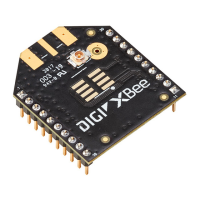Manage End Devices Recommended sleep current measurements
Digi XBee® 3 Zigbee® RF Module
161
n Each GPIO input line that has no pullup or pull-down resistor (is floating) has an indeterminate
voltage which can change over time and temperature in an indeterminate manner.
MicroPython (with optional pin wake)
The MicroPython sleep option allows a user's MicroPython program to exclusively control the device
sleep operation (with optional pin wake). For complete details see the Digi MicroPython Programming
Guide.
Recommended sleep current measurements
Properly measuring the sleep current helps to accurately estimate battery life requirements. To
ensure that you take proper measurements without upsetting the normal operation of the unit under
test, read the following steps.
When you measure sleep currents, it can cause problems with the devices because the equipment
that measures very low currents accurately requires a large resistor in series with the power supply.
This large resistor starves current from the device during a momentary wake cycle, forcing the
voltage to drop to brownout levels rapidly. This voltage drop places the device in a state that may
require a reset to resolve the problem.
Achieve the lowest sleep current
To achieve the lowest sleep current, you must disable brownout detectors during sleep modes. Even if
the measurement equipment automatically changes current ranges, it is often too slow and cannot
keep up with the necessary sudden short bursts. During long cyclic sleep periods, the device can wake
every 10 to 30 seconds to reset timers and perform other necessary steps. These wake times are
small and you may not notice them when measuring sleep currents.
Compensate for switching time
To compensate for the switching time of the equipment you must temporarily add an additional large
cap when you need measurements to allow for short pulses of current draw (see the following
schematic for details). A cap of 100 uF is enough to handle 1.5 milliseconds with 20 mA of current. You
can increase or decrease the capacitor based on the switching time of the measurement circuitry and
the momentary on time of the unit. Measure the leakage current of the additional cap to verify that it
does not skew the low current reading. The capacitor averages the spike in current draw. The actual
magnitude of the current spike is no longer visible, but you can account for the total energy consumed
by integrating the current over time and multiplying by the voltage.
Internal pin pull-ups
Internal pull-up/down resistors only apply to GPIO lines that are configured as disabled (0) or digital
input (3). Use PR (Pull-up/Down Resistor Enable) to enable them on a per-pin basis and use PD (Pull
Up/Down Direction) to determine the direction.
Internal pin pull-ups can pull excess current and cause the sleep current readings to be higher than
desired if you drive or float the pull-ups.
n Disable all pull-ups for input lines that have a low driven state during sleep.
n Enable pull-ups for floating lines or inputs that do not connect to other circuitry.
If you use an analog-to-digital converter (ADC) to read the analog voltage of a pin, it may not be
possible to stop all leakage current unless you can disconnect the voltage during sleep. Each floating

